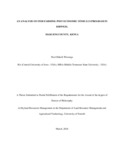| dc.description.abstract | Communities living in Arid and Semi-arid Lands (ASALs) face many challenges such as poverty, food insecurity and malnutrition, and limited means of livelihoods. This has been worsened by the rapid changing climate that has reduced communities’ resilience on pastoral livelihood. One of Kenyan government strategy to pastoral adaptation due to poor livestock returns, increased population settlements and youth unemployment has been the promotion of aquaculture along the permanent rivers of ASALs. This study analyzed the fish farming component of Economic Stimulus Program (ESP) in Kibwezi Makueni County, Kenya. The specific objectives were to: i) analyze the status of the fish farming in Kibwezi, Makueni County, ii) determine factors influencing adoption of fish farming in Kibwezi, iii) determine the profitability of ESP fish farming adopters and, iv) determine the best alternative crop to fish farming system to use water resource in ASALs. To achieve these objectives, a structured questionnaire was administered to 146 ESP farmers, several traders and consumers. A situational analysis identified two major strengths: black clay soils that are good for earth pond development and pond water waste which can be used for irrigation. Weaknesses identified were poor selection of fish pond sites, inappropriate technology (adaptive fish breeds and types) and poor socio-economic status of fish farmers. Opportunities included public-private collaboration in research, infrastructure development, extension services, proximity to permanent rivers and wildlife conflict management. An analysis of the status showed that 46.6 percent of the fish farmers enrolled under ESP promotion (2009-2012) were still practicing fish farming in 2014.
Ninety four percent of these farmers practiced tilapia monoculture on a semi intensive system. Females represented 41 percent of the sampled fish farmers. About 95 percent of the ponds were built between 2009 and 2012 with 58.9 percent of them being of the earthen type. The study
using descriptive statistics and the Logit model, assessed current 2014 data, and determined the factors influencing adoption of fish farming. The Logit analysis identified distance to fish markets (0.001), education levels of the farmer (0.004), distance to input markets (0.004), group membership (0.012) and age (0.020) of the farmer to significantly influence adoption of fish farming. The study observed a very short value chain because harvested fish was always sold in its fresh form with limited processing. About 27 percent of farmers had an average annual net cash income of Kenya Shillings (KES).24, 707.14. Farmers who stocked at least 5 fish per square metre were profitable. The study found that catfish was the most profitable culture fish and it was a close competitor of tomato production. The study recommends that fisheries extension officers promote fish farming to farmers who are located in areas with black clay soils and close to permanent sources of water. The information from this study may be appropriately used for aquaculture development in Semi and Semi-Arid Lands (ASALs). | en_US |

